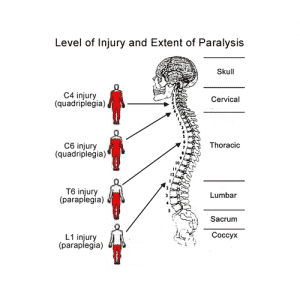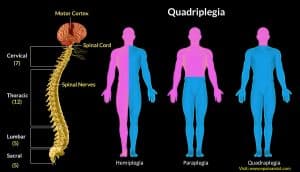Quadriplegia Injury

Quadriplegia Injury Levels
Quadriplegia injury refers to the loss of function of all four limbs due to an injury to the cervical spinal cord. Injuries that result in quadriplegia are always drastically life-changing events.The complete loss of function in the torso, upper extremities and lower extremities is extreme. The paralysis results in the need for medical devices and nursing assistance to carry out basic activities of daily living (ADLs). The need for 24 hour car and medical equipment is financially costly for the people who experience such injuries. The financial, emotional and time dedication to family members is extreme as well.
How One Becomes Quadriplegic - People who suffer from quadriplegia have sustained damage to the cervical spinal cord between segment levels C1-C8. Segment levels C1-C8 are located in the upper quarter of the spinal cord, between the base of the head and middle of the shoulder blades. The trauma in the form of severe stretching or severing to the spinal cord causes the loss of function of the limbs. The resulting obstruction to the signals from the brain to the rest of the body renders the victim paralyzed and basically eliminates their ability to move. Statistical studies point out that the top three causes of quadriplegia are injuries resulting from car accidents, falls, and sporting events. Automobile collisions cause up to or more than forty percent of new quadriplegic injuries each year on average. The condition named quadriplegia is commonly referred to as tetraplegia in places outside the United States, but both terms mean "paralysis of four limbs".
Problems Associated With Quadriplegia Injury
Upon visual examination of a quadriplegic, the most notable issue is the lack of motor and sensory to the arms and legs. Loss of function affects the torso is usually also present. This results in complications in controlling bladder and bowel activity, loss of sexual function, and difficulty with digestion and breathing. Sensory loss can affect a patient with sensations of numbness or neuropathic pain.
Quadriplegic symptoms may differ depending on the segment level where the cervical spinal cord has been injured. Trauma between C1-C4 usually affects the ability to control the upper torso, respiratory function, and arm function much more drastically than trauma between C5-C7. The most serious injuries result from trauma to segment level C1, which is located just below the base of the skull and is the highest cervical vertebra. A person who sustains damage at C1 will probably suffer from loss of function from the neck down, as well as be required to use a ventilator for assistance with breathing. A person with damage at segment level C8, will likely loss function from the chest down but retain function of their arms and most of their fingers.

quadriplegia injury
The degree of severity of the damage done to the cellular structures of the spinal cord segments can make a big difference in the results of the injury. A complete severing of the spinal cord will result in total loss of function from that segment level and below. On the other hand, a partial severing or even a serious bruise may result in varying degrees of paralysis or impairment of function. The idea that all quadriplegic patients are unable to move any extremities is a common misconception. In reality, many people who suffer from quadriplegia are able to move their limbs to a certain degree, some people can even walk as if they do not have a spinal cord injury; this all depends of the degree of severity of the initial damage.
Compensation for Quadriplegia Injury
Car accidents causing quadriplegia injury are forcefully life-changing events that result in very expensive medical bills. They require life-long medical assistance and attention to the patient from a caretaker, who may be a family member or hired help. If a person has sustained an injury that resulted in quadriplegia due to a negligent driver who has caused a collision, they have recourse in the form of a lawsuit. It is only just to expect substantial monetary compensation due to the severity of the injury. A victim may be entitled to money damages to cover costs of the following things:
- personal attendant costs
- initial medical bills and expenses
- long-term rehabilitation and care costs
- medical/adaptive devices (wheelchairs, motorized chairs, ventilators, ramps)
- emotional distress
- pain and suffering
- loss of enjoyment of life
- lost income and potential earnings
The present value of the future money costs of care is surely into the millions of US dollars. Damages for such an injury should not only cover incurred medical expenses, but all future expenses as well.
Get Help - Accident Injury Lawyer
Quadriplegia Accident Injury Lawyer Advice - Right Now!
Injury Lawyer
844-984-4878
Our Promise:

